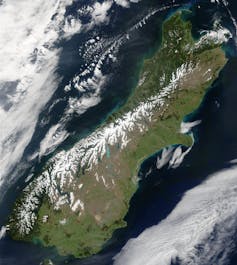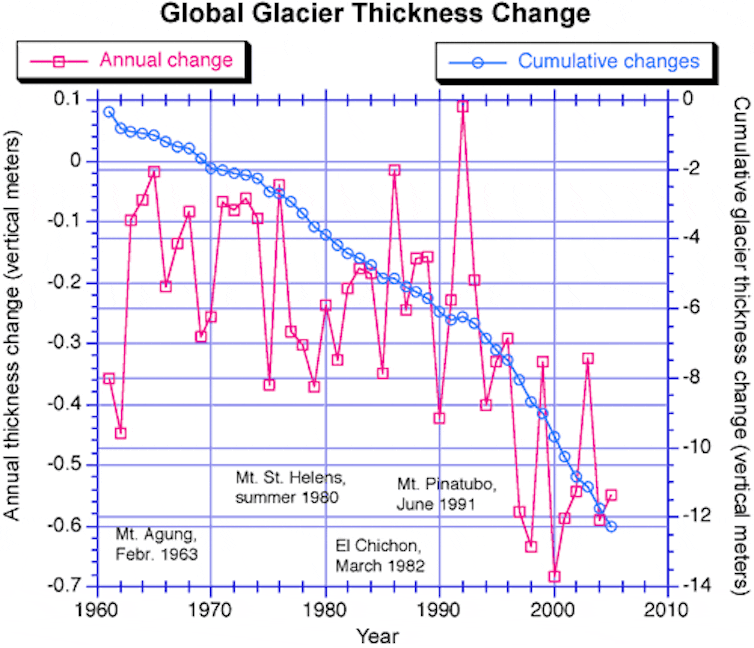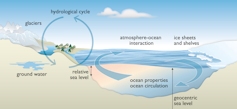“The
1890s extent of ice volume in New Zealand’s Southern Alps was 170
km3, compared to 36.1 km3 now. That disappearance of 75-80% of
Southern Alps ice is graphic evidence of the local effects of global
warming”
It is a matter of shame that there has been so little in New Zealand media (count on the fingers of ONE hand) on the demise of ice in the Southern Alps in New Zealand and the rapid retreat of our main glaciers.
About a week ago Radio NZ featured the following interview with Dave Bamford, a lifelong mountain climber. It was unscheduled and labelled by "Nghts Sport" (there are no details as to what is being discussed in the interview, and yet it gave one of the best first-person accounts of what is happening to our Alps.
Judging from what Dave is saying it would be hard to find a climate sceptic amongst the climbing fraternity because they have to live with the consequences.
Already many places have become unaccessible and passes over the mountains are in essence closed because of the danger of landslides from the collapse of the morraine wall on the sides of the ice river.
Listen to the interview. It is worth your time.
Mountaineer, Dave Bamford , describes the rapid retreat of New Zealand's glaciers

Listen to the interview here.
You can see 2 years of glacier retreat illiustrated here.
It is a matter of considerable shame that I have to report that some of the main reporting on this has been in the foreign media.
This piece of research was carried by Australia's the Conversation and not by New Zealand media.

The largely bare Southern Alps at the end of summer, 2018.
A
third of the permanent snow and ice of New Zealand’s Southern Alps
has now disappeared, according to our new research based on National
Institute of Water and Atmospheric Research aerial
surveys.
A
NASA satellite photo of the Southern Alps, stretching along New
Zealand’s South Island, shown here capped with snow in
2002. Jacques
Descloitres/NASA/Wikimedia Commons
Since
1977, the Southern Alps’ ice volume has shrunk by 18.4 km3 or
34%, and those ice losses have been accelerating rapidly in the past
15 years.
The
story of the Southern Alps’s disappearing ice has been very
dramatic – and when lined up with rapid glacier retreats in many
parts of the world, raises serious questions about future sea level
rise and coastal climate impacts.
The
Southern Alps’ total ice volume (solid line) and annual gains or
losses (bars) from 1976 to 2014 in km3 of water equivalent, as
calculated from the end-of-summer-snowline monitoring programme.
Glaciers are large-scale, highly
sensitive climate instruments, which in an ideal world we would pick
up and weigh once a year, because their fluctuations provide one of
the clearest signals of climate change. A glacier is simply the
surplus ice that collects above the permanent snowline where the
losses to summer melting are less than the gains from winter
accumulation. A glacier flows downhill and crosses the permanent
snowline from the area of snow gain to the zone of ice loss. The
altitude of this permanent snowline is the equilibrium line: it marks
the altitude at which snow gain (accumulation) is exactly balanced by
melt (ablation) and is represented by the end-of-summer snowline.
<image id= Authors, CC
BY
In
1977, one of us (Trevor Chinn) commenced aerial photography to
measure the annual end-of-summer snowline for 50 index glaciers
throughout the Southern Alps.
These
annual end-of-summer surveys have been continued
by the National Institute of Water and Atmospheric Research (NIWA).
We then use the NIWA results to calculate the annual glacier mass
balance and hence volume changes of small to medium sized glaciers in
the Southern Alps. Small to medium glaciers respond quickly to annual
variability of weather and climate, and are in balance with the
current climate.
Not
so the twelve largest glaciers: the Tasman, Godley, Murchison,
Classen, Mueller, Hooker, Ramsay, Volta/Therma, La Perouse, Balfour,
Grey, and Maud glaciers. These have a thick layer of insulating rocks
on top of the ice lower down the glaciers trunk. Their response to
new snow at the top is subdued, and take many decades to respond.
Up
until the 1970s, their surfaces lowered like sinking lids maintaining
their original areas. Thereafter, glacial lakes have formed and they
have undergone rapid retreat and ice loss.
The
Rolleston index glacier in the Southern Alps of New Zealand, showing
the accumulation area where fresh clean snow gain occurs above the
end-of-summer snowline, and the area of melting ice below. Here, a
negative balance year in 2009 shows a higher end-of-summer snowline
revealing underlying old snow. Trevor
Chinn, CC
BY
To
come up with our calculations, we have used the snowline survey data
plus earlier topographic maps and a GPS survey of the ice levels of
the largest glaciers to calculate total ice-volume changes for the
Southern Alps up until 2014.
Over
that time, ice volume had decreased 34%, from 54.5 km3 to
36.1 km3 in water
equivalents. Of that reduction, 40% was from the 12 largest glaciers,
and 60% from the small- to medium-sized glaciers.
These
New Zealand results mirror trends from mountain glaciers globally.
From 1961 to 2005, the thickness of “small” glaciers worldwide
decreased approximately 12 metres, the equivalent of more than 9,000
km3 of water.
Global
Glacier Thickness Change: This shows average annual and cumulative
glacier thickness change of mountain glaciers of the world, measured
in vertical metres, for the period 1961 to 2005. Mark
Dyurgerov, Institute of Arctic and Alpine Research, University of
Colorado, Boulder, CC
BY
Martin
Hoelzle and associates at the
World Glacier Monitoring Service have estimatedestimate
the 1890s extent of ice volume in New Zealand’s Southern Alps was
170 km3,
compared to 36.1 km3 now.
That disappearance of 75-80% of Southern Alps ice is graphic evidence
of the local effects of global warming.
Further
large losses of ice in the Southern Alps have been projected by
glaciologists Valentina Radic and Regine Hock, suggesting that only
7-12 km3 will
remain by the end of the 21st century. This is based on regional
warming projections of 1.5°C to 2.5°C. This represents a likely
devastation of ice cover of the Southern Alps over two centuries
because of global warming.
And
where does all this melted glacier ice go? Into the oceans, thus
making an important contribution to sea level rise, which poses a
serious risk to low-lying islands in the Pacific, and low-lying
coastal cities from Miami in the US to Christchurch in NZ.
In
2013, the
Intergovernmental Panel on Climate Change estimated mountain
glacier melt has contributed about 6 to 7 centimetres of sea level
rise since 1900, and project a further 10 to 20 cm from this source
by 2100.
This excellent piece camed from the New York Times
But
a local tour operator, Fox Glacier Guiding, has been unable to take
tourists onto the ice on foot since April, when glacial retreat
caused a river to change course, blocking access to a popular hiking
trail. And at another glacier about 14 miles down the road, the
operator Franz Josef Glacier Guides lost hiking access in 2012, also
because of retreating ice.
Now,
air landings by helicopter are the only way to set foot on the
glaciers, which lie at the confluence of the Southern Alps and the
Tasman Sea on the west coast of New
Zealand’s
South Island. As a result, both companies have made helicopter tours
their primary product, increasing business for local
helicopter operator.
Finally, earlier this year the gap was filled by this article in stuff.co.nz










No comments:
Post a Comment
Note: only a member of this blog may post a comment.